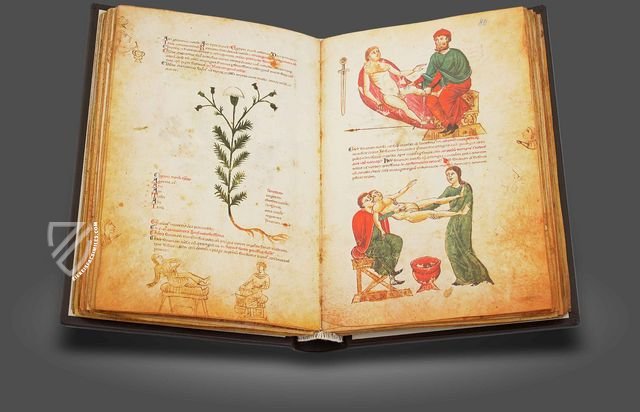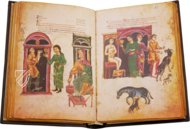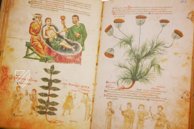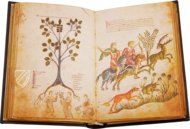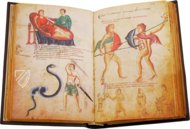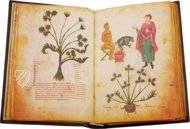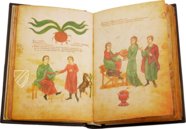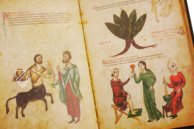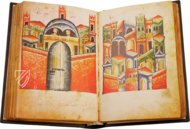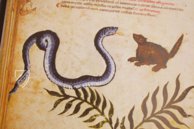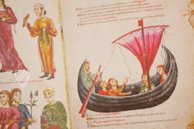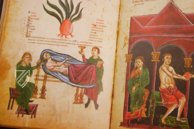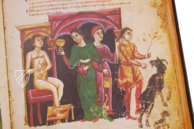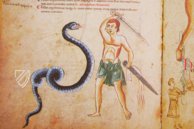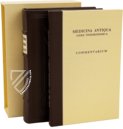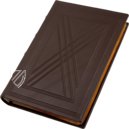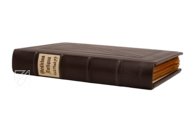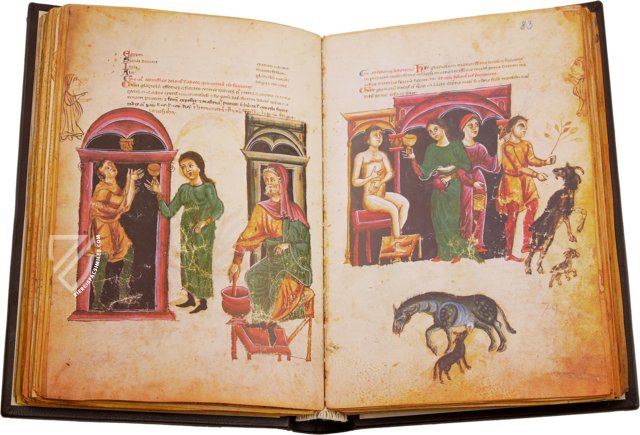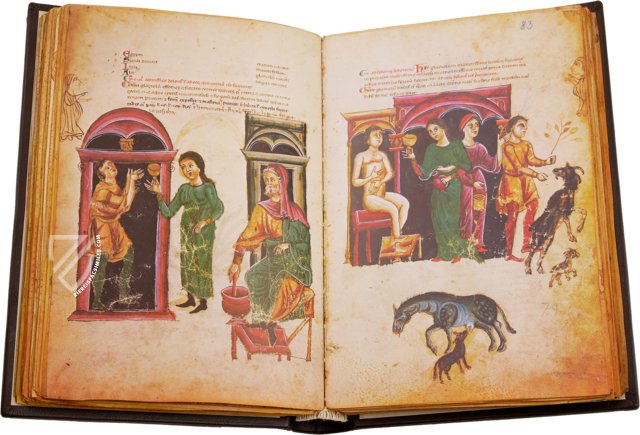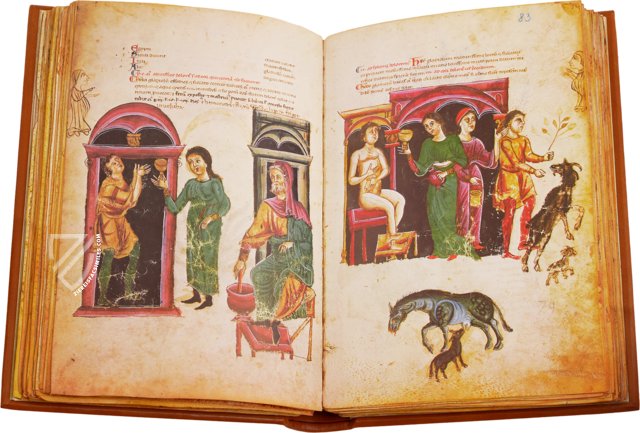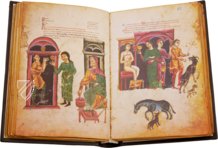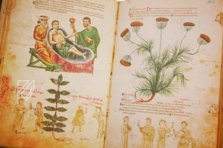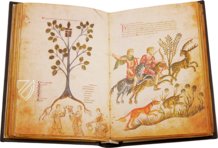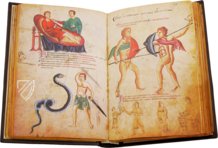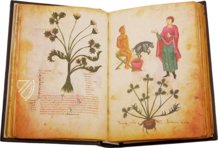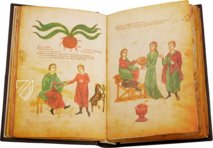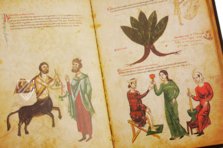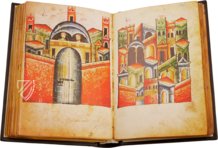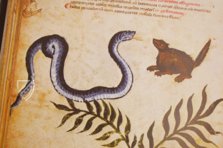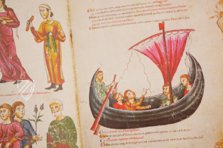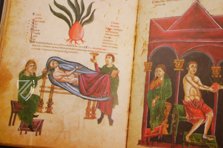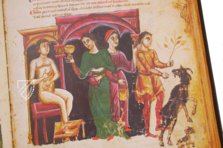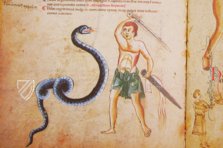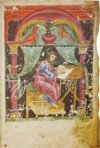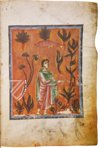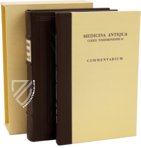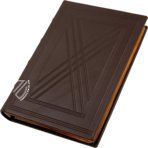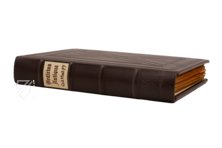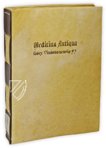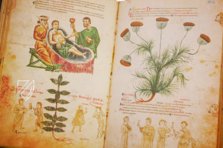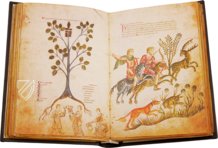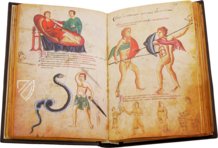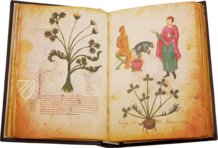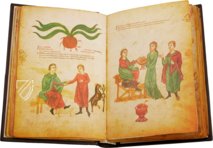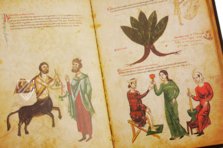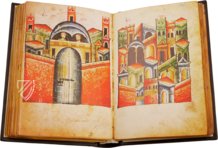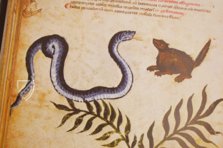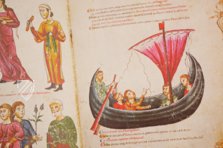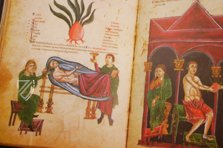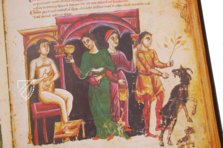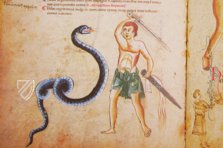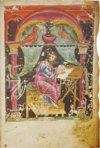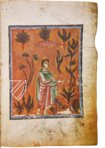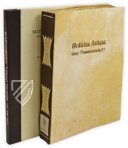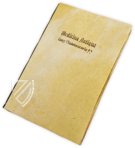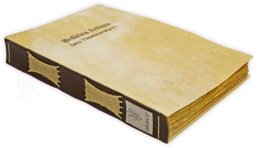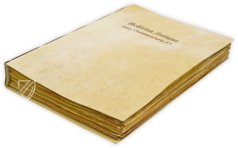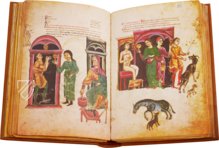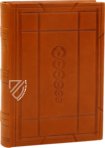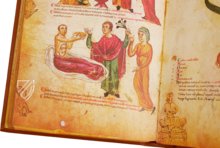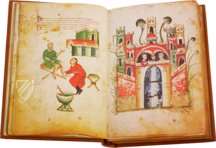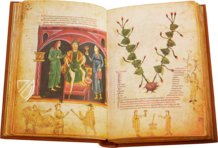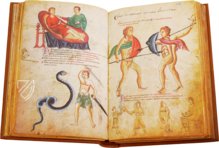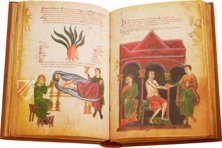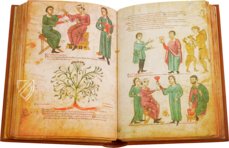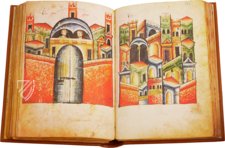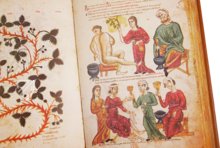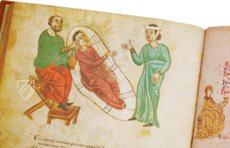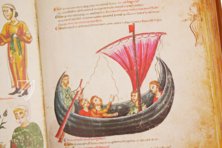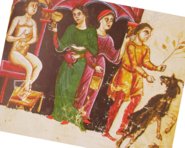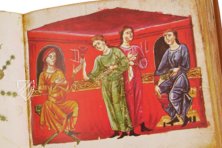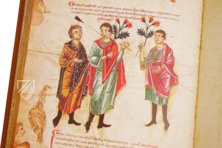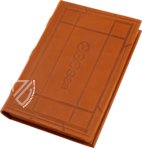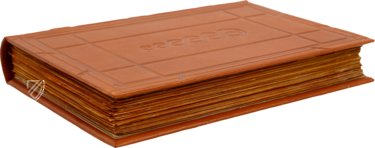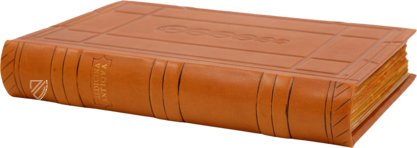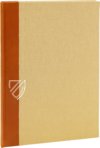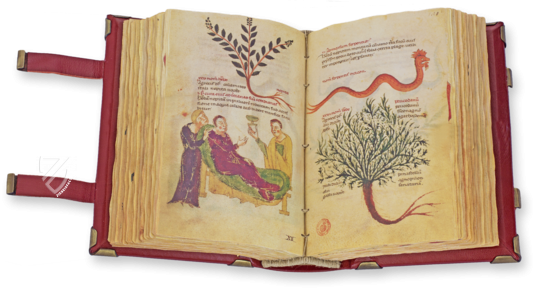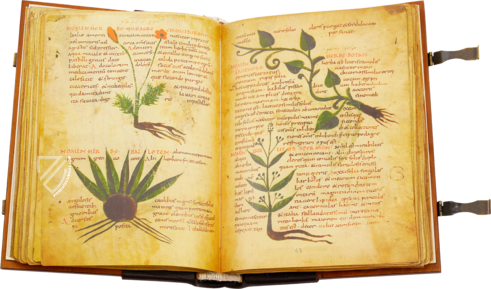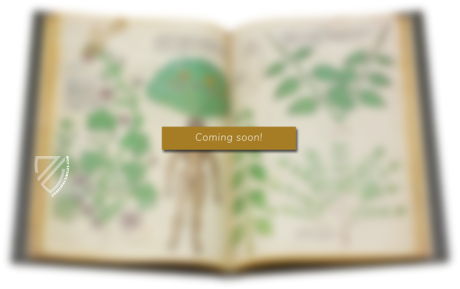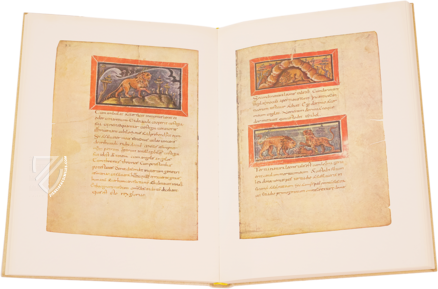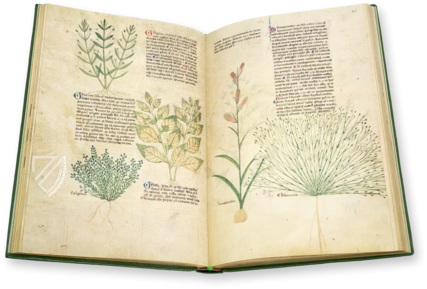Medicina Antiqua
(under 1,000€)
A medical work full of skepticism towards doctors? This actually exists: the anthology Medicina antiqua. Under this title one finds medical-pharmaceutical texts from the 4th or 5th century, which are so different that their authors cannot be grasped either biographically or by name. Produced in southern Italy in the 1st half of the 13th century, this manuscript proves how readily medical knowledge from antiquity was received in the Middle Ages and modern times. This manuscript is impressive for its numerous pictures of plants, animals, and therapeutic scenes, which are executed in luminous opaque color painting. However, even though interesting pen and ink drawings take the viewer into the consultation hours of a medieval doctor, the style of the manuscript remains very critical of doctors: the manuscript is addressed to the layman, distrusts doctors, and therefore strongly recommends self-medication.
Medicina Antiqua
The Viennese manuscript of Medicina Antiqua, is one of the most significant manuscripts of its kind, not least for its precious illustration as it is a comprehensive medical and pharmaceutical manuscript in Latin, produced in the first half of the 13th century in Southern Italy, possibly in the environment of the Staufer court. The various texts whose authors cannot be traced, neither in biography nor even by name, go back to Late Antiquity, to the 4th or 5th century. This manuscript thus represents a testimony to the extremely popular reception of classical medical conceptions in the Middle Ages and in modern times. The fame of this codex is due to the countless images of plants and animals and the sheer wealth of therapeutic scenes and depictions of physicians. All illustrations go back to classical models and are executed in bright opaque colours. Besides them, almost each page contains feather drawings that were added some fifty years later and guide the visitor directly through the consultation hours of a medieval physician. It is a contemporary pictorial commentary with spontaneous, expressive illustrations to lend the codex a very special charm.
The Medical Knowledge of Late Antiquity in Medieval Miniatures
The authors, or more correctly, compilers, refer more or less plainly, directly or indirectly, to classical standard works such as the Materia Medica by Dioscorides, a well-known Greek botanist and physician of the 1st century, and to the Natural History of Pliny the Elder. The text is quite damaged in some parts, as certain passages and depictions were offensive to later Christian readers who tried to erase even the most minor trace of pagan elements from the manuscript. Thus, the prayers to Dea Sancta Tellus, the Holy Mother Earth, and a prayer to the plants incurred the displeasure of Christian readers so that texts were rubbed out. The female Tellus had to undergo sex modification and was changed to a Father God, as the text of this prayer was not only rubbed out in places, but also re- or overwritten. Furthermore, representations of Phalloi have been rubbed out in many places throughout the manuscript. The feather drawings, the most recent element added to the opaque colour paintings, fascinate with their coarse realism, often on the verge of caricature; the artist must in any case have been very familiar with the running of a medieval physician’s practice.
A Medical Reference Book for Daily Use
Materia Medica were intended for laymen and – utterly skeptical of the medical profession and its integrity – recommended self-medication. The general orientation of the work is thus not primarily scientific, even by the standards of this period. The individual texts were more nourished by magical ideas than by scientific theory (although the authors just as gladly referred to contemporary medical literature and accepted popular medical knowledge).
A true Treasure-Trove for Medical Historians
The continuing popularity of this comprehensive pharmaceutical volume seems to be due to a wide range of reasons. The Viennese manuscript, richly illustrated with both paintings and drawings, not only presents a truly precious object for research into the history of art but also an invaluable source for the history of medicine. Last but not least, its miniatures provide interesting details on medieval clothing, furniture and therapeutic instruments. The fact that this work is also often consulted by laymen may also be due to Pliny the Elder’s insults to physicians, whom he said should never be trusted, and the consequent praise of self-medication, or else to the wealth of magical conceptions it contains, thus underlining the miraculous aspect of any healing process.
Codicology
- Alternative Titles
- Die Medicina Antiqua
Libri quattuor medicinae - Size / Format
- 322 pages / 27.5 × 18.6 cm
- Origin
- Italy
- Date
- 1st half of the 13th century
- Epochs
- Style
- Language
- Script
- Textura Rotunda
- Illustrations
- More than 400 illustrations, including 6 full-page miniatures, most of them in color, partly with gold, pen drawings in the margin
- Content
- Anthology of medical-pharmaceutical texts from late antiquity
Medicina Antiqua
Treating Shingles
Shingles is a viral disease-causing painful rashes and blisters on the skin, which can last for weeks. Not only is it related to the childhood disease chickenpox, but shingles is actually a reactivation of the virus. This advanced knowledge of the inner workings of the affliction was naturally unknown to medieval physicians, who instead focused on treating the symptoms. With a vaccine many centuries away, a soothing balm typically consisting of chamomile, oregano, and other plants was applied alleviate the painful rashes and blisters.
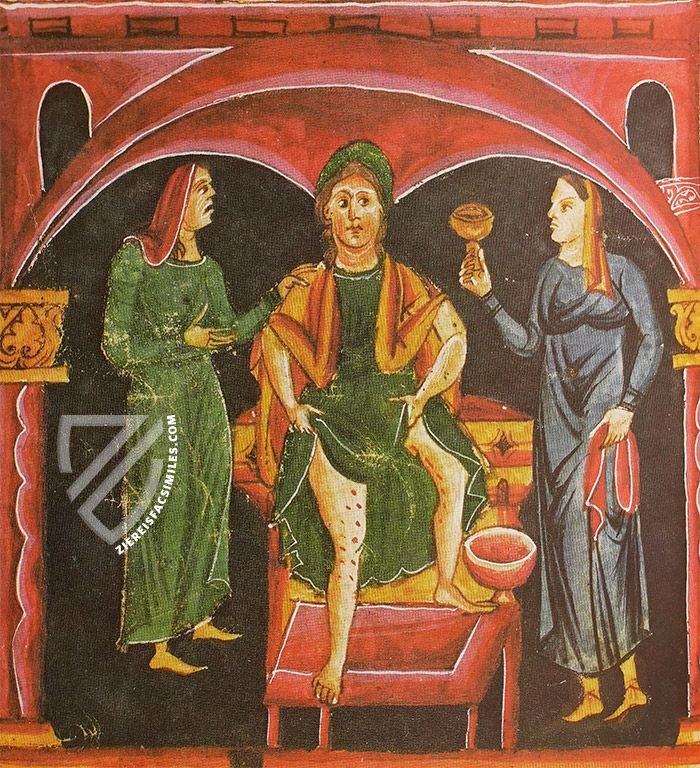
Medicina Antiqua
Invocation to the Divine Mother Earth
Aside from the actual pharmacological text, there are also many texts referring to ancient pagan mythology in this manuscript and the artwork is clearly based on a template from Late Antiquity. The poem praecatio terrae appears on the backside of this miniature and has only been superficially de-paganized by changing Dea sancta Tellus (Holy Goddess Earth) to Deo sancto (To the Holy God).
A poet kneels and recites his ode before the Magna Mater, a Roman adaptation of the Anatolian mother goddess Cybele, who is often depicted with a cornucopia. She is dressed in a green toga and rests on a serpent with blood coming out of its mouth. The figure watching from the water is a river god with a paddle and a trident who is accompanied by a strange horned creature.
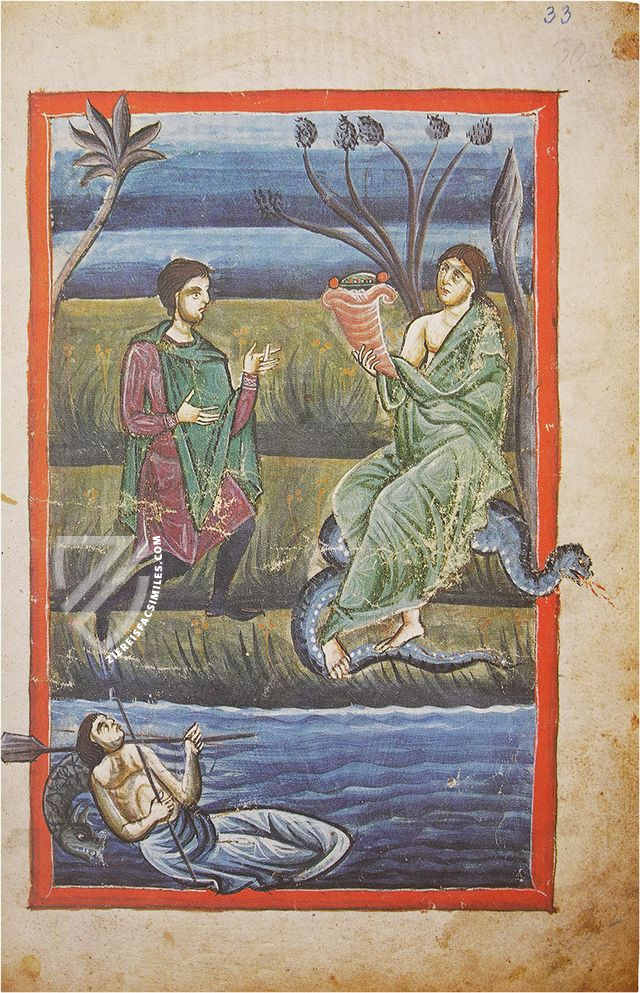
#1 Die Medicina Antiqua
Languages: English, German
(under 1,000€)
#2 Die Medicina Antiqua
Languages: English, German
(1,000€ - 3,000€)
#3 Medicina antiqua: Libri quattuor medicinae
Language: French
(1,000€ - 3,000€)
- Treatises / Secular Books
- Apocalypses / Beatus
- Astronomy / Astrology
- Bestiaries
- Bibles / Gospels
- Chronicles / History / Law
- Geography / Maps
- Saints' Lives
- Islam / Oriental
- Judaism / Hebrew
- Single Leaf Collections
- Leonardo da Vinci
- Literature / Poetry
- Liturgical Manuscripts
- Medicine / Botany / Alchemy
- Music
- Mythology / Prophecies
- Psalters
- Other Religious Books
- Games / Hunting
- Private Devotion Books
- Other Genres
- Afghanistan
- Armenia
- Austria
- Belgium
- Belize
- Bosnia and Herzegovina
- China
- Colombia
- Costa Rica
- Croatia
- Cyprus
- Czech Republic
- Denmark
- Egypt
- El Salvador
- Ethiopia
- France
- Germany
- Greece
- Guatemala
- Honduras
- Hungary
- India
- Iran
- Iraq
- Israel
- Italy
- Japan
- Jordan
- Kazakhstan
- Kyrgyzstan
- Lebanon
- Liechtenstein
- Luxembourg
- Mexico
- Morocco
- Netherlands
- Palestine
- Panama
- Peru
- Poland
- Portugal
- Romania
- Russia
- Serbia
- Spain
- Sri Lanka
- Sweden
- Switzerland
- Syria
- Tajikistan
- Turkey
- Turkmenistan
- Ukraine
- United Kingdom
- United States
- Uzbekistan
- Vatican City
- A. Oosthoek, van Holkema & Warendorf
- Aboca Museum
- Ajuntament de Valencia
- Akademie Verlag
- Akademische Druck- u. Verlagsanstalt (ADEVA)
- Aldo Ausilio Editore - Bottega d’Erasmo
- Alecto Historical Editions
- Alkuin Verlag
- Almqvist & Wiksell
- Amilcare Pizzi
- Andreas & Andreas Verlagsbuchhandlung
- Archa 90
- Archiv Verlag
- Archivi Edizioni
- Arnold Verlag
- ARS
- Ars Magna
- ArtCodex
- AyN Ediciones
- Azimuth Editions
- Badenia Verlag
- Bärenreiter-Verlag
- Belser Verlag
- Belser Verlag / WK Wertkontor
- Benziger Verlag
- Bernardinum Wydawnictwo
- BiblioGemma
- Biblioteca Apostolica Vaticana (Vaticanstadt, Vaticanstadt)
- Bibliotheca Palatina Faksimile Verlag
- Bibliotheca Rara
- Boydell & Brewer
- Bramante Edizioni
- Bredius Genootschap
- Brepols Publishers
- British Library
- C. Weckesser
- Caixa Catalunya
- Canesi
- CAPSA, Ars Scriptoria
- Caratzas Brothers, Publishers
- Carus Verlag
- Casamassima Libri
- Centrum Cartographie Verlag GmbH
- Chavane Verlag
- Christian Brandstätter Verlag
- Circulo Cientifico
- Club Bibliófilo Versol
- Club du Livre
- CM Editores
- Collegium Graphicum
- Collezione Apocrifa Da Vinci
- Comissão Nacional para as Comemorações dos Descobrimentos Portugueses
- Coron Verlag
- Corvina
- CTHS
- D. S. Brewer
- Damon
- De Agostini/UTET
- De Nederlandsche Boekhandel
- De Schutter
- Deuschle & Stemmle
- Deutscher Verlag für Kunstwissenschaft
- DIAMM
- Droz
- E. Schreiber Graphische Kunstanstalten
- Ediciones Boreal
- Ediciones Grial
- Ediclube
- Edições Inapa
- Edilan
- Editalia
- Edition Deuschle
- Edition Georg Popp
- Edition Leipzig
- Edition Libri Illustri
- Editiones Reales Sitios S. L.
- Éditions de l'Oiseau Lyre
- Editions Medicina Rara
- Editorial Casariego
- Editorial Mintzoa
- Editrice Antenore
- Editrice Velar
- Edizioni Edison
- Egeria, S.L.
- Eikon Editores
- Electa
- Emery Walker Limited
- Enciclopèdia Catalana
- Eos-Verlag
- Ephesus Publishing
- Ernst Battenberg
- Eugrammia Press
- Extraordinary Editions
- Fackelverlag
- Facsimila Art & Edition
- Facsimile Editions Ltd.
- Facsimilia Art & Edition Ebert KG
- Faksimile Verlag
- Feuermann Verlag
- Folger Shakespeare Library
- Franco Cosimo Panini Editore
- Friedrich Wittig Verlag
- Fundación Hullera Vasco-Leonesa
- G. Braziller
- Gabriele Mazzotta Editore
- Gebr. Mann Verlag
- Gesellschaft für graphische Industrie
- Getty Research Institute
- Giovanni Domenico de Rossi
- Giunti Editore
- Graffiti
- Grafica European Center of Fine Arts
- Guido Pressler
- Guillermo Blazquez
- Gustav Kiepenheuer
- H. N. Abrams
- Harrassowitz
- Harvard University Press
- Helikon
- Hendrickson Publishers
- Henning Oppermann
- Herder Verlag
- Hes & De Graaf Publishers
- Hoepli
- Holbein-Verlag
- Houghton Library
- Hugo Schmidt Verlag
- Idion Verlag
- Il Bulino, edizioni d'arte
- ILte
- Imago
- Insel Verlag
- Insel-Verlag Anton Kippenberger
- Instituto de Estudios Altoaragoneses
- Instituto Nacional de Antropología e Historia
- Introligatornia Budnik Jerzy
- Istituto dell'Enciclopedia Italiana - Treccani
- Istituto Ellenico di Studi Bizantini e Postbizantini
- Istituto Geografico De Agostini
- Istituto Poligrafico e Zecca dello Stato
- Italarte Art Establishments
- Jan Thorbecke Verlag
- Johnson Reprint Corporation
- Josef Stocker
- Josef Stocker-Schmid
- Jugoslavija
- Karl W. Hiersemann
- Kasper Straube
- Kaydeda Ediciones
- Kindler Verlag / Coron Verlag
- Kodansha International Ltd.
- Konrad Kölbl Verlag
- Kurt Wolff Verlag
- La Liberia dello Stato
- La Linea Editrice
- La Meta Editore
- Lambert Schneider
- Landeskreditbank Baden-Württemberg
- Leo S. Olschki
- Les Incunables
- Liber Artis
- Library of Congress
- Libreria Musicale Italiana
- Lichtdruck
- Lito Immagine Editore
- Lumen Artis
- Lund Humphries
- M. Moleiro Editor
- Maison des Sciences de l'homme et de la société de Poitiers
- Manuscriptum
- Martinus Nijhoff
- Maruzen-Yushodo Co. Ltd.
- MASA
- Massada Publishers
- McGraw-Hill
- Metropolitan Museum of Art
- Militos
- Millennium Liber
- Müller & Schindler
- Nahar - Stavit
- Nahar and Steimatzky
- National Library of Wales
- Neri Pozza
- Nova Charta
- Oceanum Verlag
- Odeon
- Orbis Mediaevalis
- Orbis Pictus
- Österreichische Staatsdruckerei
- Oxford University Press
- Pageant Books
- Parzellers Buchverlag
- Patrimonio Ediciones
- Pattloch Verlag
- PIAF
- Pieper Verlag
- Plon-Nourrit et cie
- Poligrafiche Bolis
- Presses Universitaires de Strasbourg
- Prestel Verlag
- Princeton University Press
- Prisma Verlag
- Priuli & Verlucca, editori
- Pro Sport Verlag
- Propyläen Verlag
- Pytheas Books
- Quaternio Verlag Luzern
- Reales Sitios
- Recht-Verlag
- Reichert Verlag
- Reichsdruckerei
- Reprint Verlag
- Riehn & Reusch
- Roberto Vattori Editore
- Rosenkilde and Bagger
- Roxburghe Club
- Salerno Editrice
- Saltellus Press
- Sandoz
- Sarajevo Svjetlost
- Schöck ArtPrint Kft.
- Schulsinger Brothers
- Scolar Press
- Scrinium
- Scripta Maneant
- Scriptorium
- Shazar
- Siloé, arte y bibliofilia
- SISMEL - Edizioni del Galluzzo
- Sociedad Mexicana de Antropología
- Société des Bibliophiles & Iconophiles de Belgique
- Soncin Publishing
- Sorli Ediciones
- Stainer and Bell
- Studer
- Styria Verlag
- Sumptibus Pragopress
- Szegedi Tudomànyegyetem
- Taberna Libraria
- Tarshish Books
- Taschen
- Tempus Libri
- Testimonio Compañía Editorial
- Thames and Hudson
- The Clear Vue Publishing Partnership Limited
- The Facsimile Codex
- The Folio Society
- The Marquess of Normanby
- The Richard III and Yorkist History Trust
- Tip.Le.Co
- TouchArt
- TREC Publishing House
- TRI Publishing Co.
- Trident Editore
- Tuliba Collection
- Typis Regiae Officinae Polygraphicae
- Union Verlag Berlin
- Universidad de Granada
- University of California Press
- University of Chicago Press
- Urs Graf
- Vallecchi
- Van Wijnen
- VCH, Acta Humaniora
- VDI Verlag
- VEB Deutscher Verlag für Musik
- Verlag Anton Pustet / Andreas Verlag
- Verlag Bibliophile Drucke Josef Stocker
- Verlag der Münchner Drucke
- Verlag für Regionalgeschichte
- Verlag Styria
- Vicent Garcia Editores
- W. Turnowski Ltd.
- W. Turnowsky
- Waanders Printers
- Wiener Mechitharisten-Congregation (Wien, Österreich)
- Wissenschaftliche Buchgesellschaft
- Wissenschaftliche Verlagsgesellschaft
- Wydawnictwo Dolnoslaskie
- Xuntanza Editorial
- Zakład Narodowy
- Zollikofer AG

